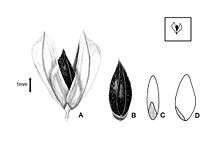Phalaris brachystachys
| Shortspike canarygrass | |
|---|---|
 | |
| Scientific classification | |
| Kingdom: | Plantae |
| (unranked): | Angiosperms |
| (unranked): | Monocots |
| (unranked): | Commelinids |
| Order: | Poales |
| Family: | Poaceae |
| Genus: | Phalaris |
| Species: | P. brachystachys |
| Binomial name | |
| Phalaris brachystachys Link[1] | |
Phalaris brachystachys, the confused canary-grass[2] or shortspike canarygrass,[3] is an annual grass with growth habits and cultural requirements similar to Phalaris aquatica. It is native to the Mediterranean region. It grows most actively during the spring and fall, while resting during the heat of midsummer and the short cool days of winter. It also must be protected from heavy freezes.
Some Phalaris species contain gramine, which can cause brain damage, other organ damage, central nervous system damage and death in sheep.[4]
While at least one strain showed an extremely strong occurrence of N,N-DMT as the sole alkaloid, other strains indicated the presence of 5-MeO-DMT as well. Strongly positive human bioassays have been reported using some clones.[5]
References
- ↑ "Phalaris brachystachys information from NPGS/GRIN". www.ars-grin.gov. Retrieved 2008-04-02.
- ↑ "BSBI List 2007". Botanical Society of Britain and Ireland. Archived from the original (xls) on 2015-02-25. Retrieved 2014-10-17.
- ↑ "Phalaris brachystachys". Natural Resources Conservation Service PLANTS Database. USDA. Retrieved 23 September 2015.
- ↑ Toxicants of Plant Origin - Google Book Search. books.google.com. Retrieved 2008-04-20.
- ↑ Ayahuasca: alkaloids, plants & analogs
External links
- "Phalaris brachystachys". Integrated Taxonomic Information System.
- USDA U.S. Range Maps
- Erowid Phalaris Vault
- The genus Phalaris (Ayahuasca: alkaloids, plants & analogs: assembled by Keeper of the Trout)